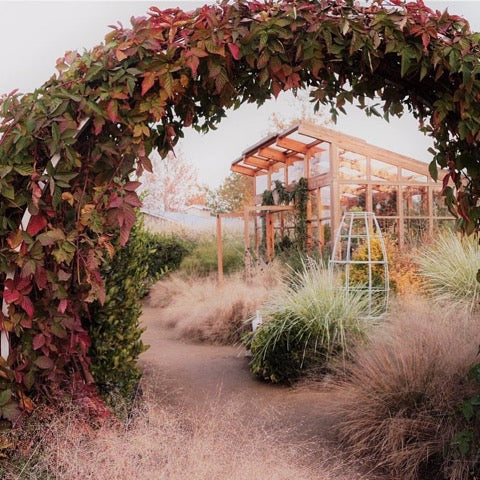We’ve been following some exciting garden design trends for 2018. Garden Design Magazine published a great list which featured a number of trends that have long played a role in our design approach. We encourage you to take a look at their list, along with similarly forward-thinking garden trend posts by Gardenista and HGTV. Consider incorporating some of them into your own outdoor design plan!
Here are a few of our favorite garden trends that we think have real staying power:
Maximizing small spaces
The past few years have seen an explosion of interest in tiny houses, micro living, and minimalism, which has resulted in innovative solutions for making the most of limited space, both indoors and out. We believe that any backyard — whether it’s a sprawling property or a little urban patio — can be transformed into a green oasis by incorporating the right elements.
In small gardens, it is important to think vertically, making the most of wall space, where climbing plants thrive and enclose the space in a curtain of greenery. Attractive, strategically placed multi-use sculptural elements, such as birdfeeders and trellises, serve a practical purpose while also providing a splash of color and texture.
Gardening with sustenance and sustainability in mind
Did you know it’s been scientifically proven that gardening is beneficial for mental and physical health? Growing plants and organic vegetables can lead to lower blood pressure, improved immune system functioning, and reduced stress.
With new farm-to-table restaurants, urban gardening initiatives and community gardens popping up in every city, it’s easy to see that people are looking for ways to incorporate sustainability and nature into their daily lives. By integrating edibles into our garden environments, we can participate in this movement in our own back or front yards.
While most think of vegetable growing as a ground-level activity, we’re continually impressed by the way that our trellises and arbors have been used to create vertical gardening environments, where squash and gherkins hang, serving not only as a delicious dinner option, but also as an attractive visual feature in a stylish gardenscape.
Container Gardening
A dynamic, eye-catching garden depends on the cohesive combination of diverse elements. Mixing different styles, textures, colors, and sizes of planters and outdoor design features is an ideal way to give your garden a makeover. In our practice, we have expanded the definition of “containers” to go beyond traditional planters and pots and incorporate the many different structural elements that plants can interact with. With a bit of imagination, trellises, tomato cages, birdfeeders, and arbors can become central focal points in a colorful, lively outdoor environment.
Embracing a feeling of enclosure
We consider outdoor environments a haven away from the rest of the world, a green refuge that helps us expel negative energy, eliminate unnecessary distractions, and focus on well-being and joy. Landscape architects agree that the positive feelings our gardens inspire are increased when we modify them to fit a human scale through the creation of a sense of enclosure. Some of our favorite strategies for increasing the coziness, comfort, and privacy of our outdoor spaces involve structural elements that allow nature to remain the central focal point.
Our Gracie Modern Arbor is often used to break up large spaces into separate areas of activity (such as dining, playing, and lounging) while creating an ideal environment for climbing plants to reach their full potential. And important way to foster a sense of enclosure in a garden is with vertical elements, and arbors and trellises are an ideal way to bring greenery up to eye level and beyond.
Landscape design for all seasons
As the days get darker and colder, gardeners are faced with the reality that their previously verdant backyards are becoming barer and grayer. However, landscape designers have lately begun to put more emphasis on solutions for winter dreariness, including using plants with contrasting textures like ornamental grasses, interesting foliage color and including artistic elements like garden sculpture and sculptural trellises as year-round perennial features.
Encouraging diverse wildlife
By now, it’s a well-known and unfortunate fact that many species of insects and birds are in danger of extinction, due in large part to loss of habitat. However, certain garden features take the needs of local animal populations into account, providing them with supportive environments filled with native plants and designated spaces to nest and feed.
Not only will these interventions foster a more sustainable and environmentally conscious outdoor space, but certain insects like bees also actively improve the overall health and productivity of a garden.
Putting emphasis on craftsmanship
Though often readily available and convenient, mass-produced items are ultimately more likely to wear down over time, especially in an outdoor environment where they’re continually subjected to the weather. Many landscape designers are finding that their clients prefer a few carefully selected, artisanal pieces to a large number of mass-produced products. A major benefit of handmade items is that artisans are frequently willing to work directly with clients to come up with specially commissioned designs that will fit seamlessly into their unique outdoor environments. Handcrafted features can easily transform an everyday garden element like a trellis, arbor or birdfeeder into an elegant and one-of-a-kind work of outdoor art.

Seeking inspiration in public gardens
One of our favorite ways to gain inspiration for outdoor design projects is to visit local public gardens that are home to countless species of plants and trees.

We love the way that the Getty Museum’s Central Garden, designed by California artist Robert Irwin, integrates plants and outdoor sculptures, turning the gardens into an interactive contemporary outdoor artwork that considers the surrounding natural environment and California design traditions.
And for those less interested in art and more enthusiastic about spending the day enjoying good food and wine, many vineyards and marketplaces (such as our studio favorite, Cornerstone Sonoma) boast beautiful outdoor gardens and spaces where you can wander through the landscape, eat and...imbibe.











